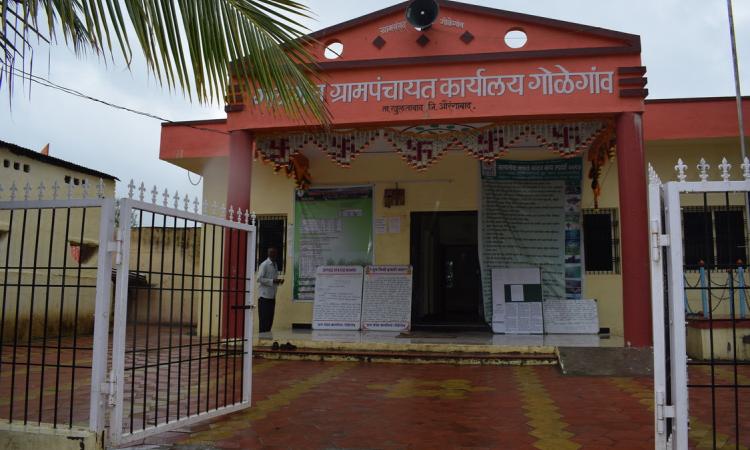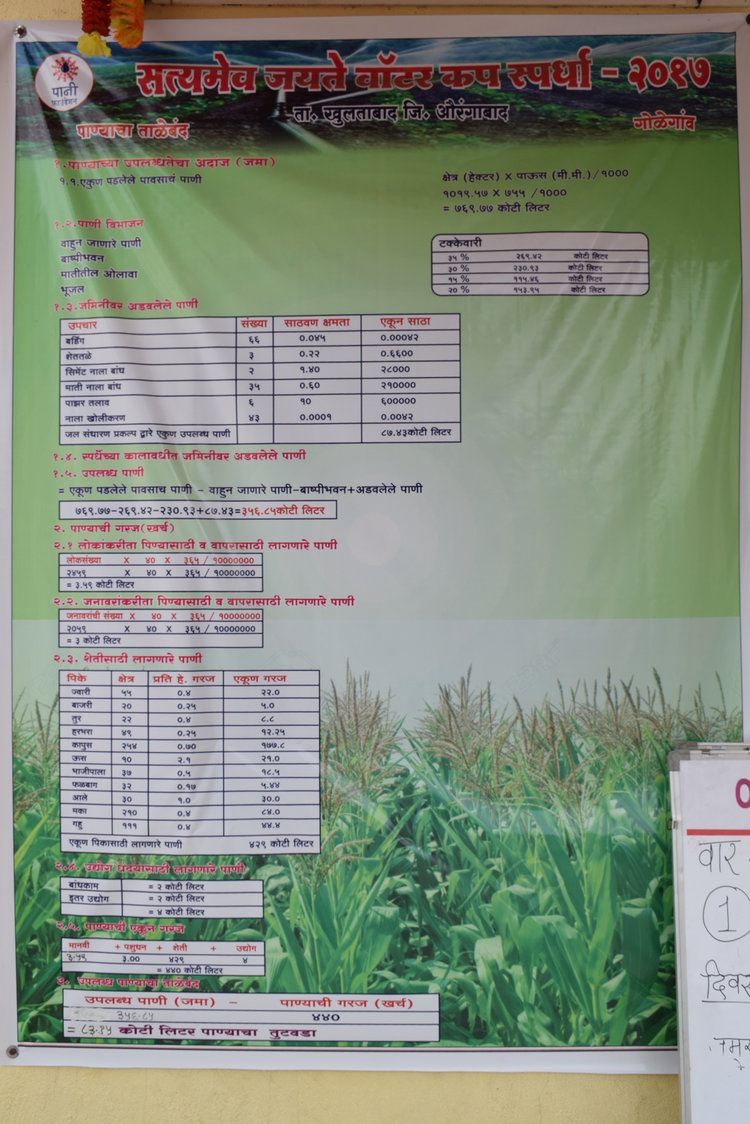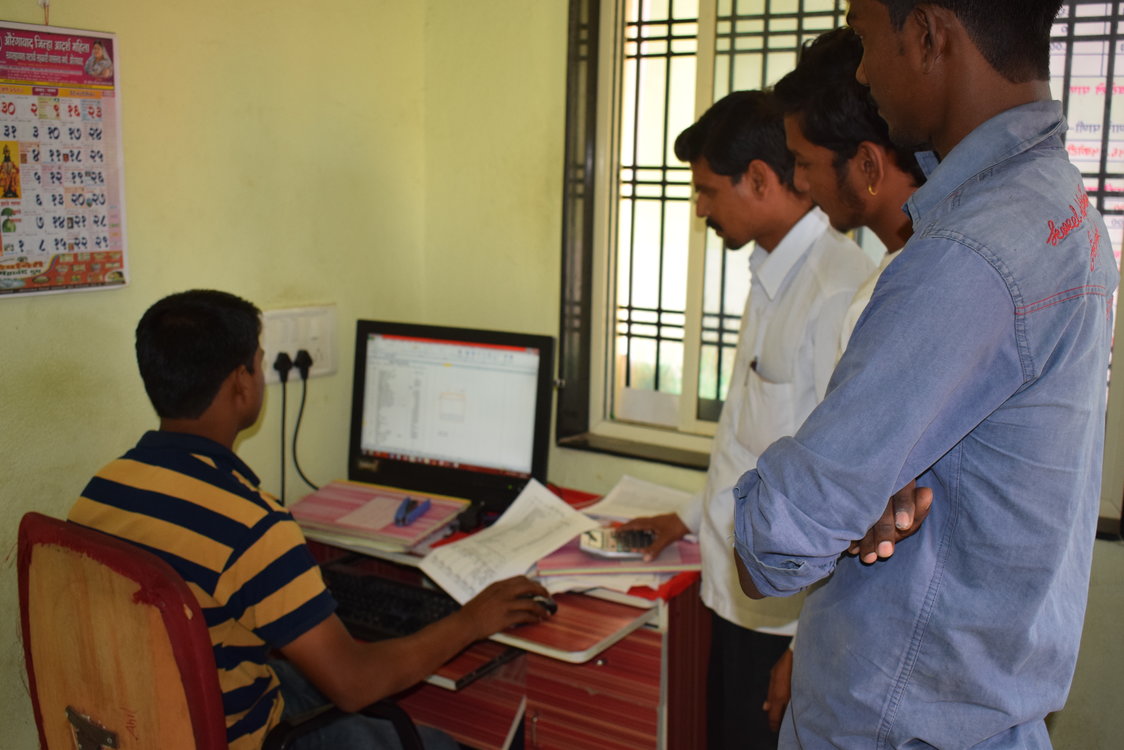
Till about a year ago, 52-year-old Kisan Jite would often wake up to his wife Sarla and other village women squabbling over who would fill their buckets first from the only well in Golegaon village. This fight would then proceed to the three water tankers allotted by the zilla parishad for the entire village with a population of 2750 people. Some days, Jite himself would queue up behind the tankers.
Not anymore. Golegaon village in Aurangabad district, one of the severely drought affected areas in the Marathwada region of Maharashtra, has learnt to work around the water situation in their village. They have come up with the novel idea of a water budget for each household. “Every household draws up a budget of their income at the start of the month where they break down money to be utilised for various chores and bills. A water budget works the same way,” says Santosh Joshi, the sarpanch of the village who came up with the idea in consultation with Uday Deolankar, sub-divisional agriculture officer from the region. 
This effort was made to cope with the severe drought situation that was persisting in the village since 2012. Joshi knew well that the solution lay in conserving the existing source of water and reducing wastage.
The budget lists out how much water should ideally be used by each of the 453 households in the village. The aim is to make optimum use of the 755-millimetre rainfall the area receives of which at least 50 percent was estimated to be going waste. Both Joshi and Deolankar collected data from each household with details of where and how the water was being used.
How the budget works
With a team of youngsters to help them, they would visit each household and collect information like the number of family members in the house, the number of cattle or any livestock owned by each one, the size of the house, the number of vehicles owned, average usage of water for washing clothes, vessels and bathing. “We drew up two tables--one for the households and the other for farms. This was then compared to the water resource available in the village and an adequate breakdown was drawn for every house and farm,” says Joshi.
They further measured the rainwater that goes waste in the village and compared it with the price of the bottled water (available at Rs 20 per litre) to gauge the enormity of the financial loss involved in wasting rainwater. “When villagers compared the water they utilised with the price of bottled water, they realised the real value of the water they wasted,” says Joshi.
“I would always try to make people aware of the need for water conservation and how we can waste less water in our day-to-day chores. The villagers would keenly listen but to get them to implement any step was very difficult,” he adds.
The team drew up campaigns to spread awareness about the problem of dwindling water resources and how they could conserve it. “We tried to show the villagers how much natural water they wasted by comparing it with bottled water price. A household water budget was the only way to get close to a figure,” says Deolankar.
Post the awareness programme, of the 453 households, only 55 complied and submitted the data. Though not all villagers participated, Joshi and Deolankar could see some progress in their behaviour.
Village gets competitive
Despite the lack of enthusiasm from the villagers, Joshi was not the one to be disheartened. The announcement of Paani Foundation’s Satyamev Jayate Water Cup gave his effort the impetus it needed. An initiative by actor Aamir Khan and his filmmaker wife Kiran Rao, the not-for-profit Paani Foundation was organising a competition, called Satyamev Jayate Water Cup, between villages to see which village could do the maximum work for watershed management and water conservation in a prescribed period.
The first edition of the competition was held during April 20 - June 5, 2016. About 116 villages took part in the competition to make their villages water-sufficient. As a result, 1,368 crore litres of water which is equivalent to 13,68,000 tankers of water worth Rs 272 crore was saved.
The first edition of water cup was a pilot project but with its success, the second edition was launched between April 8 and May 22, 2017. A total of 1300 villages from 30 tehsils took part in the second edition. Golegaon was one of them.
The competition required each village to work out a water budget for the village. Joshi, who was already working on this, hoped that enrolling in the competition would make his villagers more enthusiastic about water conservation at least for the sake of winning a competition.
The gram sabha endorsed the decision to take part in the water cup and in December 2016, a workshop was conducted at Khultabad. Paani Foundation also helped them in the process. As part of the workshop, the participants from the village were taught about the importance of watershed management and a film and a power point presentation were screened to create awareness. Later, around three training sessions on how to use water judiciously and effectively were conducted in the village through a mobile van. Villagers interacted with experts through video conferencing.
Thus, the gram sabha set the ball rolling for a systematic rainwater utilisation over a defined period of time by the village. Sarpanch Joshi and four members of the agriculture department--Uday Deolankar, Ashok Pathade, Ganesh Hange and Sunil Kolambi formed the core team of the water-budgeting project.
Joshi says that in Khultabad, they also learnt about changing crop patterns. “Farmers are still dependent on traditional farming. But with changing weather patterns, we needed to rethink ways of farming. One of the ways is to change the crop pattern of the village,” he says. Wheat, cotton and sugarcane are some of the crops grown in Golegaon. However, now farmers have been suggested to shift to less water intensive ones like vegetables and fruits, and also practise floriculture.
The water budget for the village, which now hangs outside the gram panchayat office, was made with the help of a software provided by Paani Foundation. “The software is a simple one like the data entry software and a village graduate has been appointed as the computer operator. The villagers come with details like their land papers, household information and family information and this is fed into the system,” says Joshi. The software analyses the information, breaks it down to water utilised for various purposes, accounting even the water lost through evaporation.
Villagers change with time
A markable change has been noticed in the behaviour of villagers who, though reluctant to comply with the rules initially, have made it a habit to follow water budgeting regularly.
Jite and Sarla say they conscientiously measure each bucket of water they use. “After we submitted our household data to the gram panchayat office, they suggested some changes in our water use. So, now instead of using two to three buckets of water to bathe, we use just one. We also noticed that to wash vessels, we would initially use at least four buckets of water. We brought this down to only two small tubs of water,” says Jite.
Another villager, Ajinath Jadhav (45) says that his family realised how much water gets wasted when clothes are washed daily. “Earlier, we would wash our clothes daily, irrespective of whether it was summer or winter and even when there was not much sweat. We stopped this practice and now wash clothes only once in four days and some clothing items like jeans or night clothes are washed after three to four wears,” he says. The villagers now clean their tractors only by wiping it with a wet cloth instead of using a hose pipe as they were used to.
Jite says he noticed the change when the 70-litre water drum in his house needed refilling only after two days. “Earlier we had to fill it every day but now it has come down so drastically,” Jite says. The wastewater from the kitchen and from washing cattle are not wasted and sent to farms for crops.
Other ways of conserving water
Jadhav says that they were also educated in rainwater harvesting and how they could incorporate the method with the Shet Tale scheme by the Maharashtra government which provides a subsidy to build farm ponds for the conservation of water in the farm. “Golegaon has decided to construct 70 such ponds with 15 ponds already done,” says Joshi.
Here are some other steps being taken by villagers to improve the water situation:
- Constructed Nanded pattern soak pits where the wastewater generated from every household is discharged into the pits allowing the water to percolate to the ground
- Created plantation pits where the runoff water is collected to increase the water for various crops
- Built soil and water conservation structures
- In-situ soil treatment is done by way of bio venting
- Dug recharge wells
While Golegaon did not win the water cup, the results of which were announced on August 6, the villagers have incorporated these methods into their day-to-day lives. “Water Budget is just like any other budget, be it for home, village, city, state or nation. With the budget, we have a direct comparison of supply and demand of water. Every household, village, town, and city can prepare water budget. It is the need of the day,” Joshi says.
Water availability in the village as measured
- Water collected by rain: 769.77 crore litres
- Water flowing to rivers/nullah: 269.42 crore litres
- Water lost through evaporation: 230.93 crore litres
- Humidity in the soil: 115.46 crore litres
- Groundwater: 153.95 crore litres
- Water in various dams: 87.43 crore litres
Water requirement for the village
- Water for drinking and other use: 3.59 crore litres
- Water for cattle: 3 crore litres
- Water for agriculture: 429 crore litres
- Water for construction: 2 crore litres
- Water for business: 2 crore litres
Final water budget of village
- Total water collected: 356.85 crore litres
- Water required: 440 crore litres
- Water deficit: 83.15 crore litres
(Aarteeshymal Joshi is an independent journalist and a member of 101Reporters, a pan-India network of grassroots reporters.)
/articles/budgeting-every-water-cup